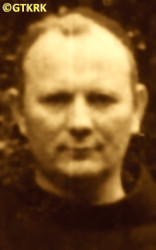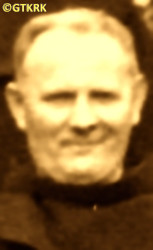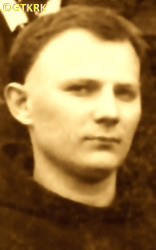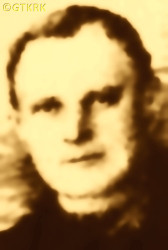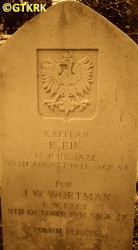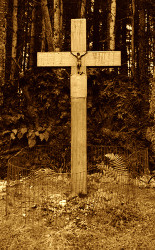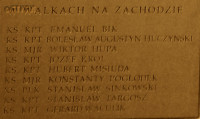Roman Catholic
St Sigismund parish
05-507 Słomczyn
85 Wiślana Str.
Konstancin deanery
Warsaw archdiocese, Poland
full list:
displayClick to display full list

searchClick to search full list by categories
wyświetlKliknij by wyświetlić pełną listę po polsku

szukajKliknij by przeszukać listę wg kategorii po polsku

Martyrology of the clergy — Poland
XX century (1914 – 1989)
personal data
surname
BIK
surname
versions/aliases
DZIESZOWSKI, ZDZIESZOWSKI
forename(s)
Emanuel
religious forename(s)
Charles (pl. Karol)
function
religious cleric
creed
Latin (Roman Catholic) Church RCmore on
en.wikipedia.org
[access: 2014.09.21]
congregation
Order of Friars Minor OFMmore on
en.wikipedia.org
[access: 2013.05.19]
(i.e. Franciscans, Minorites)
diocese / province
Assumption into Heaven of the Blessed Mary province OFMmore on
pl.wikipedia.org
[access: 2014.08.14]
Katowice diocesemore on
en.wikipedia.org
[access: 2013.05.19]
RC Military Ordinariate of Polandmore on
en.wikipedia.org
[access: 2014.12.20]
date and place
of death
29.07.1941

Newtyletoday: Angus Cou., Scotland, United Kingdom
more on
en.wikipedia.org
[access: 2020.07.31]
alt. dates and places
of death
28.08.1941
details of death
During World War I chaplain in the German Imperial Army.
After the end of military operations, took an active part in Polish preparations for the plebiscite to be held on 20.03.1921, which was to decide on the nationality of Silesia.
After German and Russian invasion of Poland in 09.1939 and start of the World War II, after start of German occupation, in danger of an imminent arrest for a couple of months went into hiding in Kraków (in Hospitaller Brothers' monastery) and Zebrzydowice — under the name Zdzieszowski.
Next through Romania crossed to Hungary, where ministered in Polish refugee camps.
In 1940, left Hungary for France, where became a chaplain in the 10th Armoured Cavalry Brigade, formed at Camp de Coëtquidan, a military camp in the town of Guer in Brittany, under the command of General Stanislav Maczek.
After the German attack on Belgium and France on 10.05.1940, at the end of 05.1940 the Brigade was transported to the vicinity of Champaubert in Champagne in the Marne department. There on 10.06.1940 it took part in the defensive battles against the attacking Germans. The Brigade was not allowed to take part in the defense of Paris, and was transported c. 150 km to the south instead, to Montbard near the Burgundy Canal, in the Côte–d'Or department in Burgundy. There on 16‐17.06.1940 it took part in the battles for that town, driving the Germans out of it. Due to the growing shortages of supplies, especially in gasoline, which caused the necessity to abandon equipment, Montbard however had to be abandoned and on 18.06.1940, in the forest near the town of Moloy in the same department, General Maczek disbanded the Brigade.
Maczek divided the soldiers into small units and ordered them to march independently to the south of France and try to get to Great Britain. Managed to do so in 06.1940.
Next in 06.1940 crossed over to UK and became chaplain at 14th Jazlowiec Uhlan Regiment of 10th Armour Mounted Brigade stationed in Scotland — in Barry Links and Perth.
There perished, probably from heart attack.
cause of death
disease
perpetrators
Germans / Russians
sites and events
«Intelligenzaktion»Click to display the description, Ribbentrop‐MolotovClick to display the description, Pius XI's encyclicalsClick to display the description, Silesian UprisingsClick to display the description
date and place
of birth
04.01.1887

Zdzieszowicetoday: Zdzieszowice gm., Krapkowice pov., Opole voiv., Poland
more on
en.wikipedia.org
[access: 2021.04.02]
religious vows
08.04.1907 (temporary)
16.04.1910 (permanent)
presbyter (holy orders)
ordination
21.06.1913

Wrocławtoday: Wrocław city pov., Lower Silesia voiv., Poland
more on
en.wikipedia.org
[access: 2021.04.02]
positions held
1940 – 1941
RC military chaplain — Polish Armed Forces (formed „in the West”), Polish Armed Forces — chaplain of the 14th Jazłowiec Uhlan Regiment in the 10th Armoured Cavalry Brigade, stationed in Scotland; in 1940 chaplain of the 10th Armoured Cavalry Brigade in France; earlier in 1939‐1940 chaplain at the Polish refugee camps in Hungary
1934 – 1939
parish priest — Panewnikitoday: part of Ligota‐Panewniki district in Katowice, Katowice city pov., Silesia voiv., Poland
more on
en.wikipedia.org
[access: 2021.08.12] ⋄ St Louis the King and Confessor monastery, Franciscans OFM ⋄ St Louis the King and Confessor RC parish ⋄ Katowicetoday: Katowice city pov., Silesia voiv., Poland
more on
en.wikipedia.org
[access: 2021.08.12] RC deanery — organizer and first parish priest
1935 – 1938
definitor (counselor to the provincial) — Assumption of the Blessed Virgin Mary province, Franciscans OFM
1929 – 1934
friar — Panewnikitoday: part of Ligota‐Panewniki district in Katowice, Katowice city pov., Silesia voiv., Poland
more on
en.wikipedia.org
[access: 2021.08.12] ⋄ St Louis the King and Confessor monastery, Franciscans OFM — discret (member of monastery's council)
1924 – 1928
superior — Wronkitoday: Wronki gm., Szamotuły pov., Greater Poland voiv., Poland
more on
en.wikipedia.org
[access: 2021.06.20] ⋄ Annunciation to the Blessed Virgin Mary monastery, Franciscans OFM — also: founder of Minor Theological Seminary (Seraphic College) and Higher Theological Seminary of Franciscan Fathers
c. 1918 – 1924
friar — Panewnikitoday: part of Ligota‐Panewniki district in Katowice, Katowice city pov., Silesia voiv., Poland
more on
en.wikipedia.org
[access: 2021.08.12] ⋄ St Louis the King and Confessor monastery, Franciscans OFM
c. 1915 – c. 1918
RC military chaplain — German Imperial Army
1913 – 1915
friar — Wrocławform.: Karłowice village
today: part of Karłowice‐Różanka neighborhood, Wrocław city pov., Lower Silesia voiv., Poland
more on
en.wikipedia.org
[access: 2021.04.02] ⋄ St Anthony of Padua monastery (at 26 John Kasprowicz Ave.), Franciscans OFM
1907 – 1913
student — Wrocławtoday: Wrocław city pov., Lower Silesia voiv., Poland
more on
en.wikipedia.org
[access: 2021.04.02] ⋄ philosophy and theology, Department of Catholic Theology, University of Wrocław [i.e. University of Wrocław (since 1945) / Frederic Wilhelm University of Silesia (1911‐1945) / Royal University i.e. Breslau Academy (1816‐1911)]
student — Wrocławform.: Karłowice village
today: part of Karłowice‐Różanka neighborhood, Wrocław city pov., Lower Silesia voiv., Poland
more on
en.wikipedia.org
[access: 2021.04.02] ⋄ Higher Theological Seminary „Antonianum”, St Anthony of Padua monastery (at 26 John Kasprowicz Ave.), Franciscans OFM
07.04.1906 – 08.04.1907
novitiate — Borki Wielkietoday: Olesno gm., Olesno pov., Opole voiv., Poland
more on
en.wikipedia.org
[access: 2021.12.18] ⋄ St Francis of Assisi monastery, Franciscans OFM
others related
in death
BORYŃSKIClick to display biography Henry, HUPAClick to display biography Victor (Fr Fortunate), KRÓLClick to display biography Joseph, MISIUDAClick to display biography Hubert Victor, POGŁÓDEKClick to display biography Constantine, TARGOSZClick to display biography Stanislav Peter
sites and events
descriptions
«Intelligenzaktion»: German: «Intelligenzaktion» (English: „Intelligence Action”) — a German program of extermination of the Polish elite, mainly the intelligentsia and leadership layers, carried out from the beginning of the occupation in w 09.1939 to 04.1940, mainly in territories directly annexed to Germany, but also in the so‐called Germ. Generalgouvernement (Eng. General Governorate), where it was called «AB‐aktion». In the first phase, immediately after the beginning of the German occupation, during military operations carried out by the Germ. Wehrmacht (Eng. Armed Forces) and the genocidal units of the Germ. Einsatzgruppen (Eng. Operational Groups) of the Germ. Sicherheitspolizei (Eng. Security Police), i.e. SiPo, and Germ. Sicherheitsdienst des Reichsführers SS (Eng. Security Service of the Reichsführer SS), i.e. SD, organized by the Germ. Reichssicherheitshauptamt (Eng. Reich Main Security Office), i.e. RSHA, which followed the troops, carried out under the Germ. Unternehmen „Tannenberg” (Eng. Operation „Tannenberg”) — based on the so‐called Germ. Sonderfahndungsliste (Eng. Special Wanted Lists), i.e. proscription lists of Poles considered particularly dangerous to the Third Reich, prepared by the Zentralstelle II/P (Polen) unit of the German RSHA. Later, implemented by the German civilian occupation authorities and the genocidal unit of the Germ. Volksdeutscher Selbstschutz (Eng. Ethnic Germans Self‐Defense), whose members were Germ. Volksdeutsche (Eng. Ethnic Germans), i.e. representatives of the German minority in Poland. According to various sources, these lists, at the beginning of 09.1939, could have contained the details of 61,000—88,000 „dangerous” Poles — although these figures cannot be confirmed. In total, during this genocide, c. 50,000 teachers, Catholic priests, representatives of the landed gentry, freelancers, social and political activists, and retired military personnel were systematically and methodically murdered. Another 50,000 were sent to concentration camps, where only a negligible percentage survived. (more on: en.wikipedia.orgClick to attempt to display webpage
[access: 2014.10.04])
Ribbentrop‐Molotov: Genocidal Russian‐German alliance pact between Russian leader Joseph Stalin and German leader Adolf Hitler signed on 23.08.1939 in Moscow by respective foreign ministers, Mr. Vyacheslav Molotov for Russia and Joachim von Ribbentrop for Germany. The pact sanctioned and was the direct cause of joint Russian and German invasion of Poland and the outbreak of the World War II in 09.1939. In a political sense, the pact was an attempt to restore the status quo ante before 1914, with one exception, namely the „commercial” exchange of the so‐called „Kingdom of Poland”, which in 1914 was part of the Russian Empire, fore Eastern Galicia (today's western Ukraine), in 1914 belonging to the Austro‐Hungarian Empire. Galicia, including Lviv, was to be taken over by the Russians, the „Kingdom of Poland” — under the name of the General Governorate — Germany. The resultant „war was one of the greatest calamities and dramas of humanity in history, for two atheistic and anti‐Christian ideologies — national and international socialism — rejected God and His fifth Decalogue commandment: Thou shall not kill!” (Abp Stanislav Gądecki, 01.09.2019). The decisions taken — backed up by the betrayal of the formal allies of Poland, France and Germany, which on 12.09.1939, at a joint conference in Abbeville, decided not to provide aid to attacked Poland and not to take military action against Germany (a clear breach of treaty obligations with Poland) — were on 28.09.1939 slightly altered and made more precise when a treaty on „German‐Russian boundaries and friendship” was agreed by the same murderous signatories. One of its findings was establishment of spheres of influence in Central and Eastern Europe and in consequence IV partition of Poland. In one of its secret annexes agreed, that: „the Signatories will not tolerate on its respective territories any Polish propaganda that affects the territory of the other Side. On their respective territories they will suppress all such propaganda and inform each other of the measures taken to accomplish it”. The agreements resulted in a series of meeting between two genocidal organization representing both sides — German Gestapo and Russian NKVD when coordination of efforts to exterminate Polish intelligentsia and Polish leading classes (in Germany called «Intelligenzaktion», in Russia took the form of Katyń massacres) where discussed. Resulted in deaths of hundreds of thousands of Polish intelligentsia, including thousands of priests presented here, and tens of millions of ordinary people,. The results of this Russian‐German pact lasted till 1989 and are still in evidence even today. (more on: en.wikipedia.orgClick to attempt to display webpage
[access: 2015.09.30])
Pius XI's encyclicals: Facing the creation of two totalitarian systems in Europe, which seemed to compete with each other, though there were more similarities than contradictions between them, Pope Pius XI issued in 03.1937 (within 5 days) two encyclicals. In the „Mit brennender Sorge” (Eng. „With Burning Concern”) published on 14.03.1938, condemned the national socialism prevailing in Germany. The Pope wrote: „Whoever, following the old Germanic‐pre‐Christian beliefs, puts various impersonal fate in the place of a personal God, denies the wisdom of God and Providence […], whoever exalts earthly values: race or nation, or state, or state system, representatives of state power or other fundamental values of human society, […] and makes them the highest standard of all values, including religious ones, and idolizes them, this one […] is far from true faith in God and from a worldview corresponding to such faith”. On 19.03.1937, published „Divini Redemptoris” (Eng. „Divine Redeemer”), in which criticized Russian communism, dialectical materialism and the class struggle theory. The Pope wrote: „Communism deprives man of freedom, and therefore the spiritual basis of all life norms. It deprives the human person of all his dignity and any moral support with which he could resist the onslaught of blind passions […] This is the new gospel that Bolshevik and godless communism preaches as a message of salvation and redemption of humanity”… Pius XI demanded that the established human law be subjected to the natural law of God , recommended the implementation of the ideal of a Christian state and society, and called on Catholics to resist. Two years later, National Socialist Germany and Communist Russia came together and started World War II. (more on: www.vatican.vaClick to attempt to display webpage
[access: 2023.05.28], www.vatican.vaClick to attempt to display webpage
[access: 2023.05.28])
Silesian Uprisings: Three armed interventions of the Polish population against Germany in 1919‐1921 aiming at incorporation of Upper Silesia and Opole region into Poland, after the revival of the Polish state in 1918. Took place in the context of a plebiscite ordered on the basis of the international treaty of Versailles of 28.06.1919, ending the First World War, that was to decide national fate of the disputed lands. The 1st Uprising took place on 16‐24.08.1919 and broke out spontaneously in response to German terror and repression against the Polish population. Covered mainly Pszczyna and Rybnik counties and part of the main Upper Silesia industrial district. Suppressed by the Germans. 2nd Uprising took place on 19‐25.08.1920 in response to numerous acts of terror of the German side. Covered the entire area of the Upper Silesia industrial district and part of the Rybnik county. As a result Poles obtained better conditions for the campaign prior the plebiscite. The poll was conducted on 20.03.1921. The majority of the population — 59.6% — were in favor of Germany, but the results were influenced by the admission of voting from former inhabitants of Upper Silesia living outside Silesia. As a result the 3rd Uprising broke out, the largest such uprising of the Silesian in the 20th century. It lasted from 02.05.1921 to 05.07.1921. Spread over almost the entire area of Upper Silesia. Two large battles took place in the area of St. Anna Mountain and near Olza. As a result on 12.10.1921 the international plebiscite commission decided on a more favorable for Poland division of Upper Silesia. The territory granted to Poland was enlarged to about ⅓ of the disputed territory. Poland accounted for 50% of metallurgy and 76% of coal mines. (more on: en.wikipedia.orgClick to attempt to display webpage
[access: 2020.05.25])
sources
personal:
www.encyklo.plClick to attempt to display webpage
[access: 2021.12.19], pl.wikipedia.orgClick to attempt to display webpage
[access: 2014.05.09]
original images:
www.mojaszkocja.comClick to attempt to display webpage
[access: 2019.10.13], prowincja.panewniki.plClick to attempt to display webpage
[access: 2019.10.13], prowincja.panewniki.plClick to attempt to display webpage
[access: 2019.10.13], www.mojaszkocja.comClick to attempt to display webpage
[access: 2019.10.13], www.bsip.miastorybnik.plClick to attempt to display webpage
[access: 2021.12.19], www.mojaszkocja.comClick to attempt to display webpage
[access: 2019.10.13], www.mojaszkocja.comClick to attempt to display webpage
[access: 2019.10.13], en.tracesofwar.comClick to attempt to display webpage
[access: 2014.05.09]
LETTER to CUSTODIAN/ADMINISTRATOR
If you have an Email client on your communicator/computer — such as Mozilla Thunderbird, Windows Mail or Microsoft Outlook, described at WikipediaPatrz:
en.wikipedia.org, among others — try the link below, please:
LETTER to CUSTODIAN/ADMINISTRATORClick and try to call your own Email client
If however you do not run such a client or the above link is not active please send an email to the Custodian/Administrator using your account — in your customary email/correspondence engine — at the following address:

giving the following as the subject:
MARTYROLOGY: BIK Emanuel
To return to the biography press below:
 Click to return to biography
Click to return to biography








